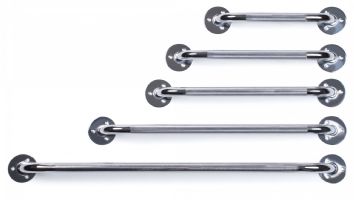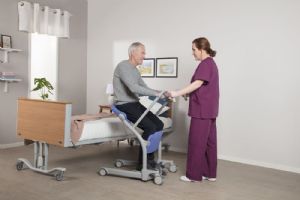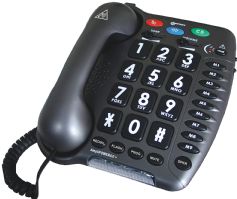~1.jpg&newwidth=80) Written by Jeanine Clancy, MEd, BSN, RN
Written by Jeanine Clancy, MEd, BSN, RN
A home’s living room - set up for comfort and enjoyment - could actually pose safety issues for people aging at home. As we get older, our abilities, needs, and requirements change, which can make it challenging to navigate around rooms that were set up years ago. From the layout to the furniture, adjustments that make it easier to get around help eliminate fall risks and maintain independence. This article focuses on home safety for seniors and creating a living room that supports safely aging in place. You’ll be surprised how making a few of these suggested changes can have a significant impact on daily quality of life, and contribute to continued comfort and enjoyment of the space.
 | Lumex Bathroom Grab Bars From Graham Field View Product |
Grab bars are often found in the bathroom, but anyone who needs to steady themselves while standing or walking can benefit from having grab bars in other places around the house. In the living room, grab bars can make a big difference next to where you usually sit to make getting up easier, and they can be placed along a wall for support while you walk to another room.
If you are concerned about how the typically industrial-looking grab bars with a metal finish will change the look and feel of a room, you can find versions that will fit in better with your decor and look more like a decorative rail. Still, your safety is more important than aesthetics and should be the number one priority.
There might not be any major changes needed to accommodate home safety for seniors. Adjusting the living room layout can make a big difference just by eliminating hazards and creating convenient access for necessities.
The Americans with Disabilities Act design standards says you need a cleared 5’ x 5’ space in your living room to provide adequate access. This could require moving some furniture and clearing floor space to create a safer environment. Here are some things to consider when arranging a living room to accommodate safely aging in place.
The layout of the living room contributes greatly to home safety for the elderly. Falls are a leading cause of injury and diminished quality of life among seniors, and the items included in the living room layout can have a notable impact on the risk of a fall. With a few additions, your living room can be turned into a safer space to support aging at home.
 | VivaLift! Radiance Series Power Lift Chairs View Product |
An old comfy recliner might be a favorite resting spot, but there are newer models that provide comfort and lift assistance. A power recliner has an electric mechanism that raises and lowers the user between a standing and sitting position at the touch of a button. This contributes to home safety for seniors by easing the load on knees and hips while getting in and out of a recliner.
Different models have different features, including the degree of recline, the reclining mechanism, and the position of the footrest. A two-position lift chair reclines to 45 degrees and is perfect for watching tv. A three-position chair can recline to almost flat, so it can serve as a place to sit or lounge to take a nap. An infinite position lift chair reclines to a flat position and has a footrest that can be adjusted separately. This type of chair supports people who have poor circulation and might need to use the Trendelenburg position, positioning the feet higher than the head. The adjustability of the footrest helps people who need their feet lifted while they are in the seated position.
Fit is something to consider when shopping for a lift chair. If a chair is too big, your feet won’t be able to touch the floor when the chair is in the raised position. If the chair is too big, it might not provide appropriate back support. It’s also important to ensure the chair has the proper weight capacity to accommodate the user.
The layout of the room needs to factor in the space requirements of the recliner. The further the chair reclines, the more space is required behind it to recline and in front of it to accommodate the footrest and allow for easy exit from the chair when it is raised to the standing lifted position.
These chairs come in different finishes to match existing living room decor. In addition to how it looks, practical considerations include how easy the surface is to clean.
Special features on some models include heated seats, a massage function, and cup holders.
A couch grab bar is a seat lifting device to help seniors easily and safely rise to a standing position or lower to a sitting position on the couch. They provide maximum support of the user’s body weight and leverage while transitioning to a sitting or standing position.
These mobility assistants are positioned on top or between the couch cushions, and the handles are usually adjustable and placed to be reached easily. The base will adjust to accommodate a range of furniture and cushions.
Also referred to as a couch cane, a couch grab bar is easy to install and is a popular choice to contribute to home safety for seniors. These devices don’t take up a lot of space and can fit a wide range of existing furniture.
 | Great Grips Doorknob Covers View Product |
 | Easy Turn Lampswitch Extension View Product |
Arthritis is a common ailment faced by many seniors, and it can make daily activities difficult. Turning a door knob, unplugging a cord, or turning a lamp on or off can be painful or even impossible for someone with arthritis in their hands.
Using these handy helpers can help reduce pain and strain on damaged joints. They allow people to accomplish daily life activities that help them maintain their independence while aging at home.
Living room flooring can play a big role in home safety for seniors. The biggest question people have about home safety for seniors regarding flooring is whether to use carpet or hardwood.
Common conditions that come with aging can contribute to mobility challenges that compromise home safety for the elderly. Balance issues, muscle weakness, joint degeneration, pain, disease, and neurological issues can negatively affect mobility. There are several products designed to help users aging at home maintain independence while safely navigating around their home.
A ceiling lift transfers people who can’t independently move from one place to another. With caregiver assistance, a user is placed in a lift harness or sling, then raised, moved, and lowered by the ceiling lift.
A permanent ceiling lift has a permanently attached motor to an overhead track, and the user is moved along that track.
A portable ceiling lift can be used in multiple rooms. The motor can be moved from a track in one room to another track for use in a different room.
They come with two-function or four-function motors. A two-function lift offers lifting and lowering and requires a caregiver to propel the user along the track. A four-function motor lifts, lowers, and can independently move the user along the track.
Ceiling lifts can be purchased with bundled pre-packaged features, or customized to fit your individual needs.
Rehabmart has created a list of 5 Best Patient Ceiling Lifts describing the features and benefits of our most recommended ceiling lifts.
Going up and down stairs is one of the most hazardous activities for seniors aging at home. Pain, inflexibility, balance, or vision issues can contribute to difficulty navigating stairs. Stairlifts use electric motors to carry users in chairs up and down staircases along metal tracks. Most models can be used inside or outside and have a weight capacity of 350 pounds.
A stairlift is a significant investment, and Rehabmart has created a Stair Lift Buying Guide to help you make an informed purchasing decision and determine if a stair lift is appropriate for your home.
.jpg&newwidth=365&maxheight=200) | Rubber Threshold Entry Ramp by National Ramp View Product |
A threshold ramp is a cost effective way to make getting around inside in a wheelchair, scooter, or walker easier when there are uneven floor surfaces. If the doorway to your living room has a high threshold, or you have stairs or a sunken living room, a threshold ramp makes it possible to get in and out of the room without going over any obstacles. These ramps are available in many shapes and sizes to fit your living room. If you know the exact measurements of the threshold, a metal version provides a solid smooth surface. Other ramps are made of rubber, and can be cut to fit your specific space.
 | Acrobat Adjustable Overbed Table with Wheels by Platinum Health View Product |
 | Bamboo Omni Tray Table and Transfer Handle View Product |
When your mobility is limited and you spend a lot of time in a chair or wheelchair, you might not be able to get close enough to a standard table to perform daily activities. An adjustable height rolling table can be rolled up closely to your chair and positioned with the tabletop right over your lap. This gives you a convenient place to eat, read, write, work on your laptop, or place things you need to have close at hand. These are usually designed as overbed tables, but many of them can also slide up next to a wheelchair.
 | Sara Stedy Patient Transfer Aid by ArjoHuntleigh (FULLY ASSEMBLED) View Product |
Standing lifts, also known as sit-to-stand lifts, stand up lifts, stand aids, and stand assist lifts, are highly maneuverable in tight spaces and under low beds. They use slings or straps to support the upper body. With feet placed on a platform and knees against a knee block, the user is raised to a standing position as their weight is transferred to their legs. They can be transported to another seat on the lift, or step off the lift and walk themselves if they are able.
For anyone who is at risk for a fall while getting up from a seated position, this device decreases the risk of a living room fall. It also greatly reduces the amount of physical strain put on a caregiver during transfers.
There are many types of transfer devices, and some are perfectly designed for use in a living room to accommodate aging at home. See our Complete Guide to Patient Transfer Devices & How to Use Them for a deeper dive into all the device options to determine if a patient lift is right for your home.
 | Drive Devilbiss iGO2 Portable Oxygen Concentrator View Product |
It’s not uncommon for seniors to rely on supplemental oxygen, which not only makes them more comfortable, but also improves stamina, alertness, mood, and sleep. It also contributes to independence while aging in place by supporting participation in everyday life activities.
Traditionally, oxygen therapy was delivered by large oxygen tanks, but technology now allows for smaller, lightweight, more convenient oxygen concentrators to be used. They take in ambient air and convert it to pure oxygen, and never have to be refilled. Home models run on regular power and are easy to roll around a room. Portable battery-operated models are great to take along when you’re out of the house. To see the features and benefits of both types, check out our articles on Best Home Oxygen Concentrators and Best Portable Oxygen Concentrators. Find out all you need to know about this therapy by reading Oxygen Therapy: The Complete Guide.
Smart technology can be used to control door locks, lights, thermostats, smoke and carbon dioxide detectors, appliances, security systems, and virtual home assistants. This contributes to home safety for seniors by eliminating the fall risk that comes from getting up to manage devices around the home. You can remain seated comfortably in your living room while maintaining control of a wide range of electronics. Additionally, family members can monitor a senior from another room or another location, adding another layer of security.
The living room is one of the hubs of the home. Common living room activities include watching tv, napping, reading, eating, doing crafts, reading, and socializing. Safely enjoying daily activities in the living room is made easier with small changes and additions to the space.
 | Flash Furniture Electric Height Adjustable Standing Desk - Table Top 48" Wide - 24" Deep View Product |
Height adjustable work tables are a great addition to the living room for anyone who needs a table is wheelchair height or anyone who likes to alternate between sitting and standing to support posture, circulation, and even digestion. Electrically powered and manual hand-crank models are available. To compare features and benefits, read about our Height Adjustable Desks for sale.
~26.jpg&newwidth=365&maxheight=200) | Hands-Free Travel and Reading Light - Beam N Read Low Vision Lamp View Product |
Daily living aids, also known as independent living aids, can be used to make a living room safer and more comfortable for anyone facing vision, hearing, and mobility challenges. Magnifying Lamps, Large Print Playing Cards, Sewing Aids, Book Stands, and Adaptive Writing Pens are some of the daily living aids for sale that solve problems and contribute to comfort and home safety for the elderly.
Aging can negatively impact eyesight, so lighting becomes more important as the years go on. Accidents are more likely to happen if obstacles can’t be seen clearly, and one overhead light in the living room might not be enough to adequately light the space. Floor lamps and table lamps add light to the room, and ultra-efficient LED lighting can reduce headaches, and nausea and impact symptoms of Alzheimer’s disease and related dementias, mood disorders, stress, vision loss and eye disorders. Putting lighting on a timer is an inexpensive way to turn lights off and on without having to get up and risk a fall to do it.
 | Geemarc AmpliPower 60 Telephone for the Hearing Impaired View Product |
 | The Chair Speaker - CS3 Wireless TV Speakers for Hard of Hearing View Product |
Hearing impairments can keep you from reacting to doorbells, smoke detectors, alarms, or incoming phone calls. The adaptive technology of Hearing Impaired Alert Devices can alert you to things around the house you have trouble hearing. Making and receiving phone calls is common in the living room, and our list of Best Hearing Impaired Telephones allows you to continue staying in touch with others while providing a lifeline in case you need to call for help.
Creating a living room focused on home safety for seniors supports maintaining independence and aging in place. As needs evolve, making just a few changes can have a big impact by reducing the risk of a fall and making the living room more convenient and comfortable.
Thank you for reading about creating a senior-friendly living room. For more information and additional buying guides and product reviews, visit Caregiver University. Rehabmart has created this popular platform specifically to help caregivers make informed decisions about the medical equipment that best suits their situation.

Jeanine has been a nurse for twenty-seven years with an extensive background in perioperative services, school/community health, quality/education, and leadership/administrative roles. Jeanine creates high-quality health content and is a mom (to 4 fabulous kids), dog mom, and avid hiker.